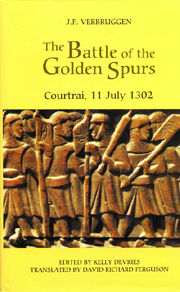 The Battle of the Golden Spurs (Courtrai, 11 July 1302)
The Battle of the Golden Spurs (Courtrai, 11 July 1302) from Part One - Historiography and the Study of the Sources
Published online by Cambridge University Press: 12 September 2012
The Emergence of Flemish and French Versions
The glorious Flemish victory beneath the walls of Courtrai did not bring an end to the war. It was clearly evident that the most powerful prince in the West would make an immediate attempt to wipe away the shame brought by the defeat. The Flemings understood that their defence had to be organised quickly. All considered, the victors of 11 July 1302 represented only half of the county, these being Bruges and the Bruges Franc, the coastal areas, the areas around Courtrai and Aalst. Ghent was still in the hands of Flemish followers of the King; only a few hundred of those who had been banished from the town, and had fled, took part in the battle. Ypres only sent a moderate contingent. Lille, Douai and all of those lands that later formed French Flanders were still occupied by royal troops. Would the inhabitants of such towns, and the surrounding countryside, accept the possibility of successfully resisting the powerful King of France? In order to convince them, the rebels acted very skilfully. After the merry news of the victory had driven out the patricians at Ghent and made powerless those Flemish favourable to the King, an armed delegation entered the town triumphantly. Never had such a celebration been seen before. No man worked that day. The victors had brought their armour and weapons with them: the blood-stained, damaged armour and split shields all proved how violently battle had been waged and how the townsmen had risked their lives against the Flemish supporters of the King and their French allies.
To save this book to your Kindle, first ensure no-reply@cambridge.org is added to your Approved Personal Document E-mail List under your Personal Document Settings on the Manage Your Content and Devices page of your Amazon account. Then enter the ‘name’ part of your Kindle email address below. Find out more about saving to your Kindle.
Note you can select to save to either the @free.kindle.com or @kindle.com variations. ‘@free.kindle.com’ emails are free but can only be saved to your device when it is connected to wi-fi. ‘@kindle.com’ emails can be delivered even when you are not connected to wi-fi, but note that service fees apply.
Find out more about the Kindle Personal Document Service.
To save content items to your account, please confirm that you agree to abide by our usage policies. If this is the first time you use this feature, you will be asked to authorise Cambridge Core to connect with your account. Find out more about saving content to Dropbox.
To save content items to your account, please confirm that you agree to abide by our usage policies. If this is the first time you use this feature, you will be asked to authorise Cambridge Core to connect with your account. Find out more about saving content to Google Drive.